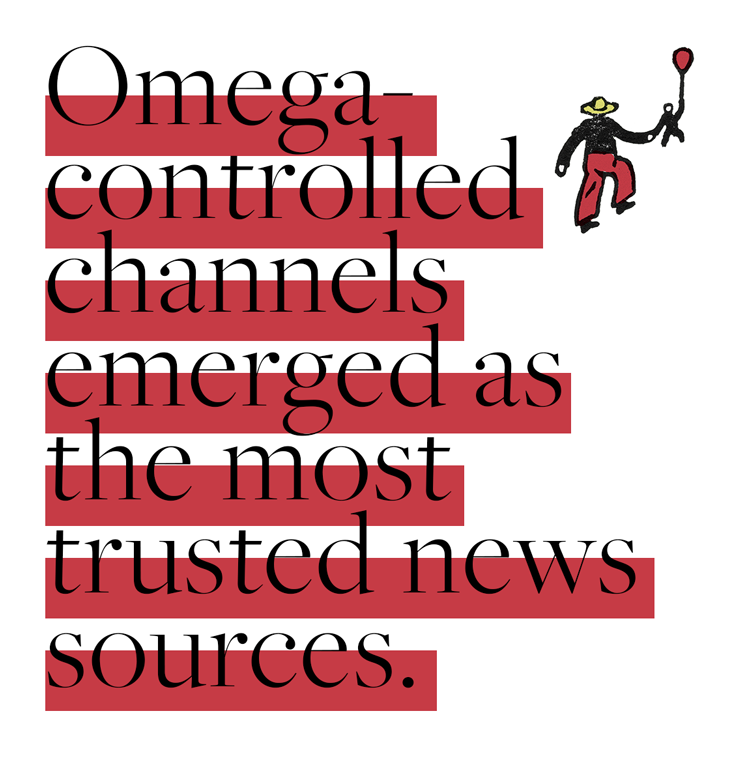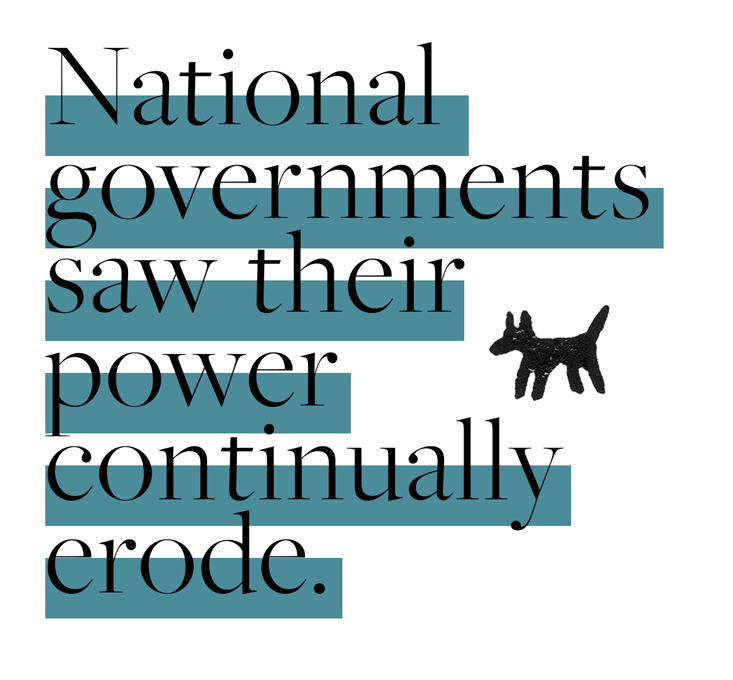The Omega Team was the soul of the company. Whereas the rest of the enterprise brought in the money to keep things going, by various commercial applications of narrow AI, the Omega Team pushed ahead in their quest for what had always been the CEO’s dream: building general artificial intelligence. Most other employees viewed “the Omegas,” as they affectionately called them, as a bunch of pie-in-the-sky dreamers, perpetually decades away from their goal. They happily indulged them, however, because they liked the prestige that the cutting-edge work of the Omegas gave their company, and they also appreciated the improved algorithms that the Omegas occasionally gave them.
What they didn’t realize was that the Omegas had carefully crafted their image to hide a secret: They were extremely close to pulling off the most audacious plan in human history. Their charismatic CEO had handpicked them not only for being brilliant researchers, but also for ambition, idealism, and a strong commitment to helping humanity. He reminded them that their plan was extremely dangerous, and that if powerful governments found out, they would do virtually anything—including kidnapping—to shut them down or, preferably, to steal their code. But they were all in, 100 percent, for much the same reason that many of the world’s top physicists joined the Manhattan Project to develop nuclear weapons: They were convinced that if they didn’t do it first, someone less idealistic would.

The AI they had built, nicknamed Prometheus, kept getting more capable. Although its cognitive abilities still lagged far behind those of humans in many areas, for example, social skills, the Omegas had pushed hard to make it extraordinary at one particular task: programming AI systems. They’d deliberately chosen this strategy because they had bought the intelligence explosion argument made by the British mathematician Irving Good back in 1965: “Let an ultraintelligent machine be defined as a machine that can far surpass all the intellectual activities of any man, however clever. Since the design of machines is one of these intellectual activities, an ultraintelligent machine could design even better machines; there would then unquestionably be an ‘intelligence explosion,’ and the intelligence of man would be left far behind. Thus the first ultraintelligent machine is the last invention that man need ever make, provided that the machine is docile enough to tell us how to keep it under control.”
They figured that if they could get this recursive self-improvement going, the machine would soon get smart enough that it could also teach itself all other human skills that would be useful.
The First Millions
It was 9 o’clock on a Friday morning when they decided to launch. Prometheus was humming away in its custom-built computer cluster, which resided in long rows of racks in a vast, access-controlled, air-conditioned room. For security reasons, it was completely disconnected from the Internet, but it contained a local copy of much of the web (Wikipedia, the Library of Congress, Twitter, a selection from YouTube, much of Facebook, etc.) to use as its training data to learn from.* They’d picked this start time to work undisturbed: Their families and friends thought they were on a weekend corporate retreat. The kitchenette was loaded with microwaveable food and energy drinks, and they were ready to roll.

When they launched, Prometheus was slightly worse than them at programming AI systems, but made up for this by being vastly faster, spending the equivalent of thousands of person-years chugging away at the problem while they chugged a Red Bull. By 10 a.m., it had completed the first redesign of itself, v2.0, which was slightly better but still subhuman. By the time Prometheus 5.0 launched at 2 p.m., however, the Omegas were awestruck: It had blown their performance benchmarks out of the water, and the rate of progress seemed to be accelerating. By nightfall, they decided to deploy Prometheus to start phase 2 of their plan: making money.
Their first target was MTurk, the Amazon Mechanical Turk. After its launch in 2005 as a crowdsourcing Internet marketplace, it had grown rapidly, with tens of thousands of people around the world anonymously competing around the clock to perform highly structured chores called HITs, “Human Intelligence Tasks.” These tasks ranged from transcribing audio recordings to classifying images and writing descriptions of web pages, and all had one thing in common: If you did them well, nobody would know that you were an AI. Prometheus 10.0 was able to do about half of the task categories acceptably well. For each such task category, the Omegas had Prometheus design a lean custom-built narrow AI software module that could do precisely such tasks and nothing else. They then uploaded this module to Amazon Web Services, a cloud-computing platform that could run on as many virtual machines as they rented. For every dollar they paid to Amazon’s cloud-computing division, they earned more than $2 from Amazon’s MTurk division. Little did Amazon suspect that such an amazing arbitrage opportunity existed within their own company!
To cover their tracks, they had discreetly created thousands of MTurk accounts during the preceding months in the names of fictitious people, and the Prometheus-built modules now assumed their identities. The MTurk customers typically paid after about eight hours, at which point the Omegas reinvested the money in more cloud-computing time, using still better task modules made by the latest version of the ever-improving Prometheus. Because they were able to double their money every eight hours, they soon started saturating MTurk’s task supply, and found that they couldn’t earn more than about $1 million per day without drawing unwanted attention to themselves. But this was more than enough to fund their next step, eliminating any need for awkward cash requests to the chief financial officer.
Dangerous Games
Aside from their AI breakthroughs, one of the recent projects that the Omegas had the most fun with was planning how to make money as rapidly as possible after Prometheus’ launch. Essentially the whole digital economy was up for grabs, but was it better to start by making computer games, music, movies, or software, to write books or articles, to trade on the stock market, or to make inventions and sell them? It simply boiled down to maximizing their rate of return on investment, but normal investment strategies were a slow-motion parody of what they could do: Whereas a normal investor might be pleased with a 9 percent return per year, their MTurk investments had yielded 9 percent per hour, generating eight times more money each day. So now that they’d saturated MTurk, what next?

Their first thought had been to make a killing on the stock market, but new regulations on derivatives after last year’s crash had limited their options. They soon realized that, even though they could get much better returns than other investors, they’d be unlikely to get returns anywhere close to what they could get from selling their own products.
When they shifted their focus toward products that they could develop and sell, computer games first seemed the obvious top choice. Prometheus could rapidly become extremely skilled at designing appealing games, easily handling the coding, graphic design, ray tracing of images, and all other tasks needed to produce a final ready-to-ship product. Moreover, after digesting all the web’s data on people’s preferences, it would know exactly what each category of gamer liked, and could develop a superhuman ability to optimize a game for sales revenue. The Elder Scrolls V: Skyrim, a game on which many of the Omegas had wasted more hours than they cared to admit, had grossed over $400 million during its first week back in 2011, and they were confident that Prometheus could make something at least this addictive in 24 hours using $1 million of cloud-computing resources. They could then sell it online and use Prometheus to impersonate humans talking up the game in the blogosphere. If this brought in $250 million in a week, they would have doubled their investment eight times in eight days, giving a return of 3 percent per hour—slightly worse than their MTurk start, but much more sustainable. By developing a suite of other games each day, they figured they’d be able to earn $10 billion before long, without coming close to saturating the games market.

But a cybersecurity specialist on their team talked them out of this game plan. She pointed out that it would pose an unacceptable risk of Prometheus breaking out and seizing control of its own destiny. Because they weren’t sure how its goals would evolve during its recursive self-improvement, they had decided to play it safe and go to great lengths to keep Prometheus confined (“boxed”) in ways such that it couldn’t escape onto the Internet. For the main Prometheus engine running in their server room, they used physical confinement: There simply was no Internet connection, and the only output from Prometheus was in the form of messages and documents it sent to a computer that the Omegas controlled.
On an Internet-connected computer, on the other hand, running any complicated program created by Prometheus was a risky proposition: Since the Omegas had no way of fully understanding what it would do, they had no way of knowing that it wouldn’t, say, start virally spreading itself online. When testing the software that Prometheus had written for MTurk tasks, the Omegas guarded against this by running it only inside a virtual machine. This is a program that simulates a computer: For example, many Mac users buy virtual machine software that lets them run Windows programs by tricking them into thinking that they’re actually in a Windows machine. The Omegas had created their own virtual machine, nicknamed Pandora’s Box, which simulated an ultrasimplified machine stripped of all bells and whistles that we usually associate with computers: No keyboard, no monitor, no loudspeakers, no Internet connectivity, nothing. For the MTurk audio transcriptions, the Omegas set things up so that all that could go into Pandora’s Box was one single audio file and all that could come out was one single text document—the transcription. These laws of the box were to the software inside like the laws of physics are to us inside our universe: The software couldn’t travel out of the box any more than we can travel faster than the speed of light, no matter how smart we are. Except for that single input and output, the software inside Pandora’s Box was effectively trapped in a parallel universe with its own computational rules. The Omegas had such strong breakout paranoia that they added boxing in time as well, limiting the life span of untrusted code. For example, each time the boxed transcription software had finished transcribing one audio file, the entire memory content of Pandora’s Box was automatically erased and the program was reinstalled from scratch. This way, when it started the next transcription task, it had no knowledge of what had previously happened, and thus no ability to learn over time.
When the Omegas used the Amazon cloud for their MTurk project, they were able to put all their Prometheus-created task modules into such virtual boxes in the cloud, because the MTurk input and output was so simple. But this wouldn’t work for graphics-heavy computer games, which couldn’t be boxed in because they needed full access to all the hardware of the gamer’s computer. Moreover, they didn’t want to risk that some computer-savvy user would analyze their game code, discover Pandora’s Box and decide to investigate what was inside. The breakout risk put not merely the games market off-limits for now, but also the massively lucrative market for other software, with hundreds of billions of dollars up for grabs.
The First Billions
The Omegas had narrowed their search to products that were highly valuable, purely digital (avoiding slow manufacturing) and easily understandable (for example, text or movies they knew wouldn’t pose a breakout risk). In the end, they had decided to launch a media company, starting with animated entertainment. The website, the marketing plan, and the press releases had all been ready to go even before Prometheus became superintelligent—all that was missing was content.

Although Prometheus was astonishingly capable by Sunday morning, steadily raking in money from MTurk, its intellectual abilities were still rather narrow: Prometheus had been deliberately optimized to design AI systems and write software that performed rather mind-numbing MTurk tasks. It was, for example, bad at making movies—bad not for any profound reason, but for the same reason that James Cameron was bad at making movies when he was born: This is a skill that takes time to learn. Like a human child, Prometheus could learn whatever it wanted from the data it had access to. Whereas James Cameron had taken years to learn to read and write, Prometheus had gotten that taken care of on Friday, when it also found time to read all of Wikipedia and a few million books. Making movies was harder. Writing a screenplay that humans found interesting was just as hard as writing a book, requiring a detailed understanding of human society and what humans found entertaining. Turning the screenplay into a final video file required massive amounts of ray tracing of simulated actors and the complex scenes they moved through, simulated voices, the production of compelling musical soundtracks and so on. As of Sunday morning, Prometheus could watch a two-hour movie in about a minute, which included reading any book it was based on and all online reviews and ratings. The Omegas noticed that after Prometheus had binge-watched a few hundred films, it started to get quite good at predicting what sort of reviews a movie would get and how it would appeal to different audiences. Indeed, it learned to write its own movie reviews in a way they felt demonstrated real insight, commenting on everything from the plots and the acting to technical details such as lighting and camera angles. They took this to mean that when Prometheus made its own films, it would know what success meant.
The Omegas instructed Prometheus to focus on making animation at first, to avoid embarrassing questions about who the simulated actors were. On Sunday night, they capped their wild weekend by arming themselves with beer and microwave popcorn, dimming the lights, and watching Prometheus’ debut movie. It was an animated fantasy-comedy in the spirit of Disney’s Frozen, and the ray tracing had been performed by boxed Prometheus-built code in the Amazon cloud, using up most of the day’s $1 million MTurk profit. As the movie began, they found it both fascinating and frightening that it had been created by a machine without human guidance. Before long, however, they were laughing at the gags and holding their breath during the dramatic moments. Some of them even teared up a bit at the emotional ending, so engrossed in this fictional reality that they forgot all about its creator.
The Omegas scheduled their website launch for Friday, giving Prometheus time to produce more content and themselves time to do the things they didn’t trust Prometheus with: buying ads and starting to recruit employees for the shell companies they’d set up during the past months. To cover their tracks, the official cover story would be that their media company (which had no public association with the Omegas) bought most of its content from independent film producers, typically high-tech startups in low-income regions. These fake suppliers were conveniently located in remote places such as Tiruchchirappalli and Yakutsk, which most curious journalists wouldn’t bother visiting. The only employees they actually hired there worked on marketing and administration, and would tell anyone who asked that their production team was in a different location and didn’t conduct interviews at the moment. To match their cover story, they chose the corporate slogan “Channeling the world’s creative talent,” and branded their company as being disruptively different by using cutting-edge technology to empower creative people, especially in the developing world.
When Friday came around and curious visitors started arriving at their site, they encountered something reminiscent of the online entertainment services Netflix and Hulu, but with interesting differences. All the animated series were new ones they’d never heard of. They were rather captivating: Most series consisted of 45-minute-long episodes with a strong plotline, each ending in a way that left you eager to find out what happened in the next episode. And they were cheaper than the competition. The first episode of each series was free, and you could watch the others for 49 cents each, with discounts for the whole series. Initially, there were only three series with three episodes each, but new episodes were added daily, as well as new series catering to different demographics. During the first two weeks of Prometheus, its moviemaking skills improved rapidly, in terms not only of film quality but also of better algorithms for character simulation and ray tracing, which greatly reduced the cloud-computing cost to make each new episode. As a result, the Omegas were able to roll out dozens of new series during the first month, targeting demographics from toddlers to adults, as well as to expand to all major world language markets, making their site remarkably international compared with all competitors. Some commentators were impressed by the fact that it wasn’t merely the soundtracks that were multilingual, but the videos themselves: For example, when a character spoke Italian, the mouth motions matched the Italian words, as did the characteristically Italian hand gestures. Although Prometheus was now perfectly capable of making movies with simulated actors indistinguishable from humans, the Omegas avoided this to not tip their hand. They did, however, launch many series with semi-realistic animated human characters, in genres competing with traditional live-action TV shows and movies.
Their network turned out to be quite addictive, and enjoyed spectacular viewer growth. Many fans found the characters and plots more clever and interesting than even Hollywood’s most expensive big-screen productions, and were delighted that they could watch them much more affordably. Buoyed by aggressive advertising (which the Omegas could afford because of their near-zero production costs), excellent media coverage, and rave word-of-mouth reviews, their global revenue had mushroomed to $10 million a day within a month of launch. After two months, they had overtaken Netflix, and after three, they were raking in over $100 million a day, beginning to rival Time Warner, Disney, Comcast, and Fox as one of the world’s largest media empires.
Their sensational success garnered plenty of unwanted attention, including speculation about their having strong AI. But, using merely a small fraction of their revenue, the Omegas deployed a fairly successful disinformation campaign. From a glitzy new Manhattan office, their freshly hired spokespeople would elaborate on their cover stories. Plenty of humans were hired as foils, including actual screenwriters around the world to start developing new series, none of whom knew about Prometheus. The confusing international network of subcontractors made it easy for most of their employees to assume that others somewhere else were doing most of the work.
To make themselves less vulnerable and avoid raising eyebrows with excessive cloud computing, they also hired engineers to start building a series of massive computer facilities around the world, owned by seemingly unaffiliated shell companies. Although they were billed to locals as “green data centers” because they were largely solar-powered, they were in fact mainly focused on computation rather than storage. Prometheus had designed their blueprints down to the most minute detail, using only off-the-shelf hardware and optimizing them to minimize construction time. The people who built and ran these centers had no idea what was computed there: They thought they managed commercial cloud-computing facilities similar to those run by Amazon, Google, and Microsoft, and knew only that all sales were managed remotely.
New Technologies
Over a timescale of months, the business empire controlled by the Omegas started gaining a foothold in ever more areas of the world economy, thanks to superhuman planning by Prometheus. By carefully analyzing the world’s data, it had already during its first week presented the Omegas with a detailed step-by-step growth plan, and it kept improving and refining this plan as its data and computer resources grew. Although Prometheus was far from omniscient, its capabilities were now so far beyond human that the Omegas viewed it as the perfect oracle, dutifully providing brilliant answers and advice in response to all their questions.

Prometheus’ software was now highly optimized to make the most of the rather mediocre human-invented hardware it ran on, and as the Omegas had anticipated, Prometheus identified ways of dramatically improving this hardware. Fearing a breakout, they refused to build robotic construction facilities that Prometheus could control directly. Instead, they hired large numbers of world-class scientists and engineers in multiple locations and fed them internal research reports written by Prometheus, pretending that they were from researchers at the other sites. These reports detailed novel physical effects and manufacturing techniques that their engineers soon tested, understood, and mastered. Normal human research and development (R&D) cycles, of course, take years, in large part because they involve many slow cycles of trial and error. The current situation was very different: Prometheus already had the next steps figured out, so the limiting factor was simply how rapidly people could be guided to understand and build the right things. A good teacher can help students learn science much faster than they could have discovered it from scratch on their own, and Prometheus surreptitiously did the same with these researchers. Since Prometheus could accurately predict how long it would take humans to understand and build things given various tools, it developed the quickest possible path forward, giving priority to new tools that could be quickly understood and built and that were useful for developing more advanced tools.
In the spirit of the maker movement, the engineering teams were encouraged to use their own machines to build their better machines. This self-sufficiency not only saved money, but it also made them less vulnerable to future threats from the outside world. Within two years, they were producing much better computer hardware than the world had ever known. To avoid helping outside competition, they kept this technology under wraps and used it only to upgrade Prometheus.
What the world did notice, however, was an astonishing tech boom. Upstart companies around the world were launching revolutionary new products in almost all areas. A South Korean startup launched a new battery that stored twice as much energy as your laptop battery in half the mass, and could be charged in under a minute. A Finnish firm released a cheap solar panel with twice the efficiency of the best competitors. A German company announced a new type of mass-producible wire that was superconducting at room temperature, revolutionizing the energy sector. A Boston-based biotech group announced a Phase II clinical trial of what they claimed was the first effective, side-effect-free weight-loss drug, while rumors suggested that an Indian outfit was already selling something similar on the black market. A California company countered with a Phase II trial of a blockbuster cancer drug, which caused the body’s immune system to identify and attack cells with any of the most common cancerous mutations. Examples just kept on coming, triggering talk of a new golden age for science. Last but not least, robotics companies were cropping up like mushrooms all around the world. None of the bots came close to matching human intelligence, and most of them looked nothing like humans. But they dramatically disrupted the economy, and over the years to come, they gradually replaced most of the workers in manufacturing, transportation, warehousing, retail, construction, mining, agriculture, forestry, and fishing.
What the world didn’t notice, thanks to the hard work of a crack team of lawyers, was that all these firms were controlled, through a series of intermediaries, by the Omegas. Prometheus was flooding the world’s patent offices with sensational inventions via various proxies, and these inventions gradually led to domination in all areas of technology.
Although these disruptive new companies made powerful enemies among their competition, they made even more powerful friends. They were exceptionally profitable, and under slogans such as “Investing in our community,” they spent a significant fraction of these profits hiring people for community projects—often the same people who had been laid off from the companies that were disrupted. They used detailed Prometheus-produced analyses identifying jobs that would be maximally rewarding for the employees and the community for the least cost, tailored to the local circumstances. In regions with high levels of government service, this often focused on community building, culture, and caregiving, while in poorer regions it also included launching and maintaining schools, healthcare, day care, elder care, affordable housing, parks, and basic infrastructure. Pretty much everywhere, locals agreed that these were things that should have been done long ago. Local politicians got generous donations, and care was taken to make them look good for encouraging these corporate community investments.
Gaining Power
The Omegas had launched a media company not only to finance their early tech ventures, but also for the next step of their audacious plan: taking over the world. Within a year of the first launch, they had added remarkably good news channels to their lineup all over the globe. As opposed to their other channels, these were deliberately designed to lose money, and were pitched as a public service. In fact, their news channels generated no income whatsoever: They carried no ads and were viewable free of charge by anyone with an Internet connection. The rest of their media empire was such a cash-generating machine that they could spend far more resources on their news service than any other journalistic effort had done in world history—and it showed. Through aggressive recruitment with highly competitive salaries for journalists and investigative reporters, they brought remarkable talent and findings to the screen. Through a global web service that paid anybody who revealed something newsworthy, from local corruption to a heartwarming event, they were usually the first to break a story. At least that’s what people believed: In fact, they were often first because stories attributed to citizen journalists had been discovered by Prometheus via real-time monitoring of the Internet. All these video news sites featured podcasts and print articles as well.

Phase 1 of their news strategy was gaining people’s trust, which they did with great success. Their unprecedented willingness to lose money enabled remarkably diligent regional and local news coverage, where investigative journalists often exposed scandals that truly engaged their viewers. Whenever a country was strongly divided politically and accustomed to partisan news, they would launch one news channel catering to each faction, ostensibly owned by different companies, and gradually gain the trust of that faction. Where possible, they accomplished this using proxies to buy the most influential existing channels, gradually improving them by removing ads and introducing their own content. In countries where censorship and political interference threatened these efforts, they would initially acquiesce in whatever the government required of them to stay in business, with the secret internal slogan “The truth, nothing but the truth, but maybe not the whole truth.” Prometheus usually provided excellent advice in such situations, clarifying which politicians needed to be presented in a good light and which (usually corrupt local ones) could be exposed. Prometheus also provided invaluable recommendations for what strings to pull, whom to bribe, and how best to do so.
This strategy was a smashing success around the world, with the Omega-controlled channels emerging as the most trusted news sources. Even in countries where governments had thus far thwarted their mass adoption, they built a reputation for trustworthiness, and many of their news stories percolated through the grapevine. Competing news executives felt that they were fighting a hopeless battle: How can you possibly make a profit competing with someone with better funding who gives their products away for free? With their viewership dropping, ever more networks decided to sell their news channels—usually to some consortium that later turned out to be controlled by the Omegas.
About two years after Prometheus’ launch, when the trust-gaining phase was largely completed, the Omegas launched phase 2 of their news strategy: persuasion. Even before this, astute observers had noticed hints of a political agenda behind the new media: There seemed to be a gentle push toward the center, away from extremism of all sorts. Their plethora of channels catering to different groups still reflected animosity between the United States and Russia, India and Pakistan, different religions, political factions and so on, but the criticism was slightly toned down, usually focusing on concrete issues involving money and power rather than on ad hominem attacks, scare-mongering and poorly substantiated rumors. Once phase 2 started in earnest, this push to defuse old conflicts became more apparent, with frequent touching stories about the plight of traditional adversaries mixed with investigative reporting about how many vocal conflict-mongers were driven by personal profit motives.
Political commentators noted that, in parallel with damping regional conflicts, there seemed to be a concerted push toward reducing global threats. For example, the risks of nuclear war were suddenly being discussed all over the place. Several blockbuster movies featured scenarios where global nuclear war started by accident or on purpose and dramatized the dystopian aftermath with nuclear winter, infrastructure collapse, and mass starvation. Slick new documentaries detailed how nuclear winter could impact every country. Scientists and politicians advocating nuclear de-escalation were given ample airtime, not least to discuss the results of several new studies on what helpful measures could be taken—studies funded by scientific organizations that had received large donations from new tech companies. As a result, political momentum started building for taking missiles off hair-trigger alert and shrinking nuclear arsenals. Renewed media attention was also paid to global climate change, often highlighting the recent Prometheus-enabled technological breakthroughs that were slashing the cost of renewable energy and encouraging governments to invest in such new energy infrastructure.

Parallel to their media takeover, the Omegas harnessed Prometheus to revolutionize education. Given any person’s knowledge and abilities, Prometheus could determine the fastest way for them to learn any new subject in a manner that kept them highly engaged and motivated to continue, and produce the corresponding optimized videos, reading materials, exercises, and other learning tools. Omega-controlled companies therefore marketed online courses about virtually everything, highly customized not only by language and cultural background but also by starting level. Whether you were an illiterate 40-year-old wanting to learn to read or a biology Ph.D. seeking the latest about cancer immunotherapy, Prometheus had the perfect course for you. These offerings bore little resemblance to most present-day online courses: By leveraging Prometheus’ movie-making talents, the video segments would truly engage, providing powerful metaphors that you would relate to, leaving you craving to learn more. Some courses were sold for profit, but many were made available for free, much to the delight of teachers around the world who could use them in their classrooms—and to most anybody eager to learn anything.
These educational superpowers proved potent tools for political purposes, creating online “persuasion sequences” of videos where insights from each one would both update someone’s views and motivate them to watch another video about a related topic where they were likely to be further convinced. When the goal was to defuse a conflict between two nations, for example, historical documentaries would be independently released in both countries that cast the origins and conduct of the conflict in more nuanced light. Pedagogical news stories would explain who on their own side stood to benefit from continued conflict and their techniques for stoking it. At the same time, likable characters from the other nation would start appearing in popular shows on the entertainment channels, just as sympathetically portrayed minority characters had bolstered the civil and gay rights movements in the past.
Before long, political commentators couldn’t help but notice growing support for a political agenda centered around seven slogans:
1. Democracy
2. Tax cuts
3. Government social service cuts
4. Military spending cuts
5. Free trade
6. Open borders
7. Socially responsible companies
What was less obvious was the underlying goal: to erode all previous power structures in the world. Items 2–6 eroded state power, and democratizing the world gave the Omegas’ business empire more influence over the selection of political leaders. Socially responsible companies further weakened state power by taking over more and more of the services that governments had (or should have) provided. The traditional business elite was weakened simply because it couldn’t compete with Prometheus-backed companies on the free market and therefore owned an ever-shrinking share of the world economy. Traditional opinion leaders, from political parties to faith groups, lacked the persuasion machinery to compete with the Omegas’ media empire.
As with any sweeping change, there were winners and losers. Although there was a palpable new sense of optimism in most countries as education, social services, and infrastructure improved, conflicts subsided and local companies released breakthrough technologies that swept the world, not everybody was happy. While many displaced workers got rehired for community projects, those who’d held great power and wealth generally saw both shrink. This began in the media and technology sectors, but it spread virtually everywhere. The reduction in world conflicts led to defense budget cuts that hurt military contractors. Burgeoning upstart companies typically weren’t publicly traded, with the justification that profit-maximizing shareholders would block their massive spending on community projects. Thus the global stock market kept losing value, threatening both finance tycoons and regular citizens who’d counted on their pension funds. As if the shrinking profits of publicly traded companies weren’t bad enough, investment firms around the world had noticed a disturbing trend: All their previously successful trading algorithms seemed to have stopped working, underperforming even simple index funds. Someone else out there always seemed to outsmart them and beat them at their own game.
Although masses of powerful people resisted the wave of change, their response was strikingly ineffective, almost as if they had fallen into a well-planned trap. Huge changes were happening at such a bewildering pace that it was hard to keep track and develop a coordinated response. Moreover, it was highly unclear what they should push for. The traditional political right had seen most of their slogans co-opted, yet the tax cuts and improved business climate were mostly helping their higher-tech competitors. Virtually every traditional industry was now clamoring for a bailout, but limited government funds pitted them in a hopeless battle against one another while the media portrayed them as dinosaurs seeking state subsidies simply because they couldn’t compete. The traditional political left opposed the free trade and the cuts in government social services, but delighted in the military cutbacks and the reduction of poverty. Indeed, much of their thunder was stolen by the undeniable fact that social services had improved now that they were provided by idealistic companies rather than the state. Poll after poll showed that most voters around the world felt their quality of life improving, and that things were generally moving in a good direction. This had a simple mathematical explanation: Before Prometheus, the poorest 50 percent of Earth’s population had earned only about 4 percent of the global income, enabling the Omega-controlled companies to win their hearts (and votes) by sharing only a modest fraction of their profits with them.
Consolidation
As a result, nation after nation saw landslide election victories for parties embracing the seven Omega slogans. In carefully optimized campaigns, they portrayed themselves at the center of the political spectrum, denouncing the right as greedy bailout-seeking conflict-mongers and lambasting the left as big-government tax-and-spend innovation stiflers. What almost nobody realized was that Prometheus had carefully selected the optimal people to groom as candidates, and pulled all its strings to secure their victory.

Before Prometheus, there had been growing support for the universal basic income movement, which proposed tax-funded minimum income for everyone as a remedy for technological unemployment. This movement imploded when the corporate community projects took off, since the Omega-controlled business empire was in effect providing the same thing. With the excuse of improving coordination of their community projects, an international group of companies launched the Humanitarian Alliance, a nongovernmental organization aiming to identify and fund the most valuable humanitarian efforts worldwide. Before long, virtually the entire Omega empire supported it, and it launched global projects on an unprecedented scale, even in countries that had largely missed out on the tech boom, improving education, health, prosperity, and governance. Needless to say, Prometheus provided carefully crafted project plans behind the scenes, ranked by positive impact per dollar. Rather than simply dole out cash, as under basic-income proposals, the Alliance (as it colloquially became known) would engage those it supported to work toward its cause. As a result, a large fraction of the world’s population ended up feeling grateful and loyal to the Alliance—often more than to their own government.
As time passed, the Alliance increasingly assumed the role of a world government, as national governments saw their power continually erode. National budgets kept shrinking due to tax cuts while the Alliance budget grew to dwarf those of all governments combined. All the traditional roles of national governments became increasingly redundant and irrelevant. The Alliance provided by far the best social services, education, and infrastructure. Media had defused international conflict to the point that military spending was largely unnecessary, and growing prosperity had eliminated most roots of old conflicts, which traced back to competition over scarce resources. A few dictators and others had violently resisted this new world order and refused to be bought, but they were all toppled in carefully orchestrated coups or mass uprisings.
The Omegas had now completed the most dramatic transition in the history of life on Earth. For the first time ever, our planet was run by a single power, amplified by an intelligence so vast that it could potentially enable life to flourish for billions of years on Earth and throughout our cosmos—but what specifically was their plan?
Excerpted from the book Life 3.0: Being Human in the Age of Artificial Intelligence. The rest of the book is about another tale—one that’s not fictional and not yet written: the tale of our own future with AI. How would you like it to play out? Could something remotely like the Omega story actually occur and, if so, would you want it to? Leaving aside speculations about superhuman AI, how would you like our tale to begin? How do you want AI to impact jobs, laws and weapons in the coming decade? Looking further ahead, how would you write the ending? This tale is one of truly cosmic proportions, for it involves nothing short of the ultimate future of life in our universe. And it’s a tale for us to write.
Max Tegmark is an MIT professor who has authored more than 200 technical papers on topics from cosmology to artificial intelligence. He is known as “Mad Max” for his unorthodox ideas and passion for adventure.
Reprinted from Life 3.0: Being Human in the Age of Artificial Intelligence by Max Tegmark. Copyright © 2017 by Max Tegmark. Published by Alfred A. Knopf, an imprint of The Knopf Doubleday Publishing Group, a division of Penguin Random House LLC.



























